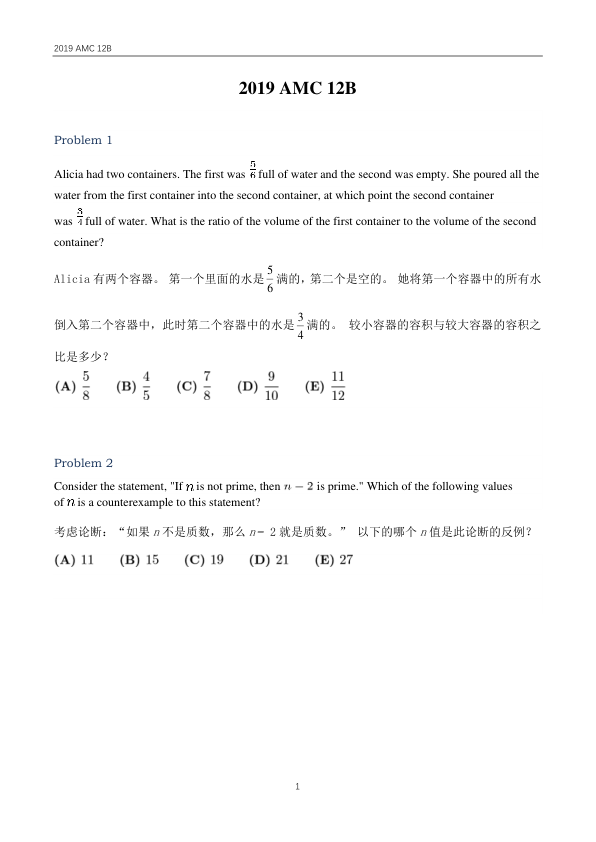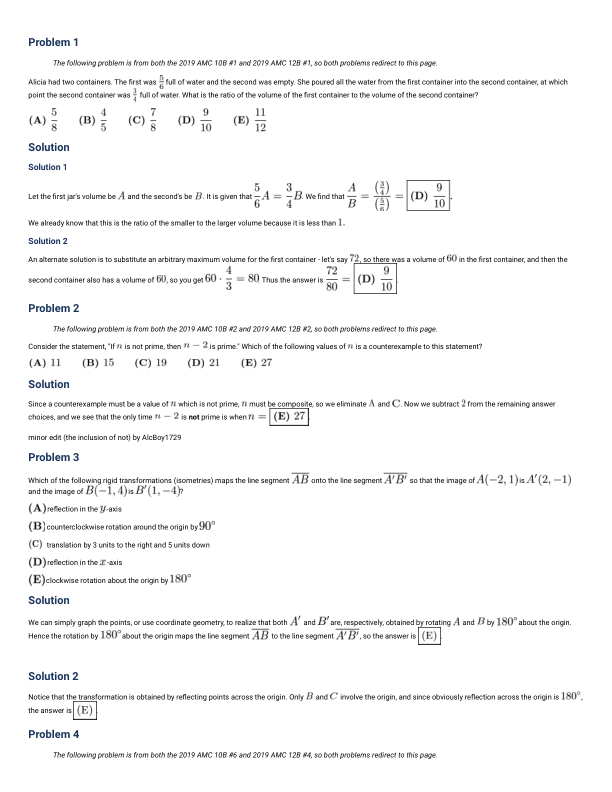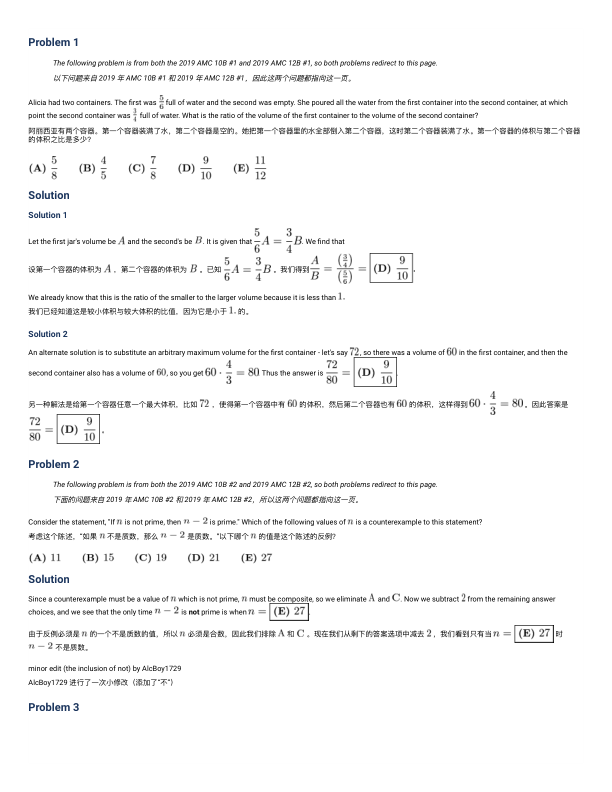2019 AMC amc12b 真题 答案 详解
| 序号 | 文件列表 | 说明 | ||
|---|---|---|---|---|
| 1 | 2019-amc12b-paper-eng-zh.pdf | 12 页 | 564.90KB | 中英双语真题 |
| 2 | 2019-amc12b-paper-eng.pdf | 5 页 | 233.09KB | 英文真题 |
| 3 | 2019-amc12b-key.pdf | 1 页 | 10.27KB | 真题答案 |
| 4 | 2019-amc12b-solution-eng.pdf | 35 页 | 2.84MB | 真题文字详解(英文) |
| 5 | 2019-amc12b-solution-eng-zh.pdf | 53 页 | 3.19MB | 真题文字详解(中英双语) |
| 6 | 2019-amc12b-solution-video-zh.mp4 | 31.52 分钟 | 65.29MB | 真题视频详解(普通话) |
中英双语真题
2019 AMC 12B
Problem 1
Alicia had two containers. The first was (\frac{5}{6}) full of water and the second was empty. She poured all the water from the first container into the second container, at which point the second container was (\frac{3}{4}) full of water. What is the ratio of the volume of the first container to the volume of the second container?
Alicia 有两个容器。第一个里面的水是 (\frac{5}{6}) 满的,第二个是空的。她将第一个容器中的所有水倒入第二个容器中,此时第二个容器中的水是 (\frac{3}{4}) 满的。较小容器的容积与较大容器的容积之比是多少?
[ \begin{array}{ll} \text{(A)} & \frac{5}{8} \ \text{(B)} & \frac{4}{5} \ \text{(C)} & \frac{7}{8} \ \text{(D)} & \frac{9}{10} \ \text{(E)} & \frac{11}{12} \end{array} ]
Problem 2
Consider the statement, "If (n) is not prime, then (n-2) is prime." Which of the following values of (n) is a counterexample to this statement?
考虑论断:“如果 (n) 不是质数,那么 (n - 2) 就是质数。”以下的哪个 (n) 值是此论断的反例?
(A) 11
(B) 15
(C) 19
(D) 21
(E) 27

英文真题
2019 AMC 12B Problems Problem 1 Alicia had two containers. The first was (\frac{5}{6}) full of water and the second was empty. She poured all the water from the first container into the second container, at which point the second container was (\frac{3}{4}) full of water. What is the ratio of the volume of the first container to the volume of the second container? (A) (\frac{5}{8}) (B) (\frac{4}{5}) (C) (\frac{7}{8}) (D) (\frac{9}{10}) (E) (\frac{11}{12}) Problem 2 Consider the statement, "If (n) is not prime, then (n-2) is prime." Which of the following values of (n) is a counterexample to this statement? (A) 11 (B) 15 (C) 19 (D) 21 (E) 27 Problem 3 Which one of the following rigid transformations (isometries) maps the line segment (\overline{AB}) onto the line segment (\overline{A'B'}) so that the image of (A(-2, 1)) is (A'(2, -1)) and the image of (B(-1, 4)) is (B'(1, -4))? (A) reflection in the (y)-axis (B) counterclockwise rotation around the origin by (90^\circ) (C) translation by 3 units to the right and 5 units down (D) reflection in the (x)-axis (E) clockwise rotation about the origin by (180^\circ) Problem 4 A positive integer (n) satisfies the equation ((n+1)! + (n+2)! = 440 \cdot n!). What is the sum of the digits of (n)? (A) 2 (B) 5 (C) 10 (D) 12 (E) 15 Problem 5 Each piece of candy in a store costs a whole number of cents. Casper has exactly enough money to buy either 12 pieces of red candy, 14 pieces of green candy, or (n) pieces of purple candy. A piece of purple candy costs 20 cents. What is the smallest possible value of (n)? (A) 18 (B) 21 (C) 24 (D) 25 (E) 28 Problem 6 In a given plane, points (A) and (B) are 10 units apart. How many points (C) are there in the plane such that the perimeter of (\triangle ABC) is 50 units and the area of (\triangle ABC) is 100 square units? (A) 0 (B) 2 (C) 4 (D) 8 (E) infinitely many Problem 7 What is the sum of all real numbers (x) for which the median of the numbers 4, 6, 8, 17, and (x) is equal to the mean of those five numbers? (A) -5 (B) 0 (C) 5 (D) (\frac{15}{4}) (E) (\frac{35}{4}) Problem 8 Let (f(x) = x^2(1-x)^2). What is the value of the sum

真题文字详解(英文)
Problem 1 The following problem is from both the 2019 AMC 10B #1 and 2019 AMC 12B #1, so both problems redirect to this page. Alicia had two containers. The first was (\frac{5}{6}) full of water and the second was empty. She poured all the water from the first container into the second container, at which point the second container was (\frac{3}{4}) full of water. What is the ratio of the volume of the first container to the volume of the second container?
(A) (\frac{5}{8}) (B) (\frac{4}{5}) (C) (\frac{7}{8}) (D) (\frac{9}{10}) (E) (\frac{11}{12})
Solution Solution 1 Let the first jar's volume be (A) and the second's be (B). It is given that (\frac{5}{6} A = \frac{3}{4} B). We find that (\frac{A}{B} = \frac{\left(\frac{3}{4}\right)}{\left(\frac{5}{6}\right)} = \boxed{\text{(D)} \frac{9}{10}}). We already know that this is the ratio of the smaller to the larger volume because it is less than 1.
Solution 2 An alternate solution is to substitute an arbitrary maximum volume for the first container - let's say (72), so there was a volume of (60) in the first container, and then the second container also has a volume of (60), so you get (60 \cdot \frac{4}{3} = 80). Thus the answer is (\frac{72}{80} = \boxed{\text{(D)} \frac{9}{10}}).
Problem 2 The following problem is from both the 2019 AMC 10B #2 and 2019 AMC 12B #2, so both problems redirect to this page. Consider the statement, "If (n) is not prime, then (n-2) is prime." Which of the following values of (n) is a counterexample to this statement?
(A) (11) (B) (15) (C) (19) (D) (21) (E) (27)
Solution Since a counterexample must be a value of (n) which is not prime, (n) must be composite, so we eliminate (A) and (C). Now we subtract (2) from the remaining answer choices, and we see that the only time (n-2) is not prime when (n=\boxed{\text{(E)} 27}). minor edit (the inclusion of not) by AlcBoy1729
Problem 3 Which of the following rigid transformations (isometries) maps the line segment (\overline{AB}) onto the line segment (\overline{A'B'}) so that the image of (A(-2,1)) is (A'(2,-1)) and the image of (B(-1,4)) is (B'(1,-4))?
(A) reflection in the (y)-axis
(B) counterclockwise rotation around the origin by (90^\circ)
(C) translation by (3) units to the right and (5) units down
(D) reflection in the (x)-axis
(E) clockwise rotation about the origin by (180^\circ)
Solution We can simply graph the points, or use coordinate geometry, to realize that both (A') and (B') are, respectively, obtained by rotating (A) and (B) by (180^\circ) about the origin. Hence the rotation by (180^\circ) about the origin maps the line segment (\overline{AB}) to the line segment (\overline{A'B'}), so the answer is (\boxed{\text{(E)}}).
Solution 2 Notice that the transformation is obtained by reflecting points across the origin. Only (B) and (C) involve the origin, and since obviously reflection across the origin is (180^\circ), the answer is (\boxed{\text{(E)}}).
Problem 4 The following problem is from both the 2019 AMC 10B #6 and 2019 AMC 12B #4, so both problems redirect to this page.

真题文字详解(中英双语)
Problem 1 The following problem is from both the 2019 AMC 10B #1 and 2019 AMC 12B #1, so both problems redirect to this page. 以下问题来自2019年AMC 10B #1和2019年AMC 12B #1,因此这两个问题都指向这一页。
Alicia had two containers. The first was (\frac{5}{6}) full of water and the second was empty. She poured all the water from the first container into the second container, at which point the second container was (\frac{3}{4}) full of water. What is the ratio of the volume of the first container to the volume of the second container? 阿丽西亚有两个容器。第一个容器装了(\frac{5}{6})的水,第二个容器是空的。她把第一个容器里的水全部倒入第二个容器,这时第二个容器装满了水。第一个容器的体积与第二个容器的体积之比是多少?
(A) (\frac{5}{8}) (B) (\frac{4}{5}) (C) (\frac{7}{8}) (D) (\frac{9}{10}) (E) (\frac{11}{12})
Solution Solution 1 Let the first jar's volume be (A) and the second's be (B). It is given that (\frac{5}{6} A = \frac{3}{4} B). We find that 设第一个容器的体积为(A),第二个容器的体积为(B)。已知(\frac{5}{6} A = \frac{3}{4} B)。我们得到(\frac{A}{B} = \frac{\left(\frac{3}{4}\right)}{\left(\frac{5}{6}\right)} = \left(\textbf{(D)}\ \frac{9}{10}\right)).
We already know that this is the ratio of the smaller to the larger volume because it is less than 1. 我们已经知道这是较小体积与较大体积的比值,因为它小于1.
Solution 2 An alternate solution is to substitute an arbitrary maximum volume for the first container - let's say 72, so there was a volume of 60 in the first container, and then the second container also has a volume of 60, so you get (60 \cdot \frac{4}{3} = 80). Thus the answer is (\frac{72}{80} = \left(\textbf{(D)}\ \frac{9}{10}\right)). 另一种解法是给第一个容器任意一个最大体积,比如说72,使得第一个容器中有60的体积,然后第二个容器也有60的体积,这样得到(60 \cdot \frac{4}{3} = 80)。因此答案是(\frac{72}{80} = \left(\textbf{(D)}\ \frac{9}{10}\right)).
Problem 2 The following problem is from both the 2019 AMC 10B #2 and 2019 AMC 12B #2, so both problems redirect to this page. 以下问题来自2019年AMC 10B #2和2019年AMC 12B #2,所以这两个问题都指向这一页。
Consider the statement, "If (n) is not prime, then (n-2) is prime." Which of the following values of (n) is a counterexample to this statement? 考虑这个陈述,“如果(n)不是质数,那么(n-2)是质数。”下面哪个(n)的值是这个陈述的反例?
(A) 11 (B) 15 (C) 19 (D) 21 (E) 27
Solution Since a counterexample must be a value of (n) which is not prime, (n) must be composite, so we eliminate A and C. Now we subtract 2 from the remaining answer choices, and we see that the only time (n-2) is not prime when (n=\left(\textbf{(E)}\ 27\right)). 由于反例必须是(n)的一个不是质数的值,所以(n)必须是合数,因此我们排除A和C。现在我们从剩下的答案选项中减去2,我们看到只有当(n=\left(\textbf{(E)}\ 27\right))时,(n-2)不是质数。
minor edit (the inclusion of not) by AlcBoy1729 AlcBoy1729进行了一次小修改(添加了“不”)
AlcBoy1729进行了一个小修改(添加了“不”)

